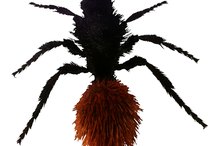Difference Between Black Ticks & Red Ticks
Ticks are a common nuisance, but at times they do more than just suck blood and leave unsightly marks. They can spread disease by the act of biting. Some may wonder about the difference between black and red ticks, but there actually are no exact species known as black or red ticks. However, there is an explanation as to why some insects might be called as such.
If you are experiencing serious medical symptoms, seek emergency treatment immediately.
Black Tick
The species that may be referred to as a black tick often actually is the black-legged tick, also known as the deer tick (Ixodes scapularis) 2. While the female has a distinct gradient color pattern on its back, the male is more uniform in its dark coloration, and can be thought of as “black.”
Red Tick
Poisonous Wood Spiders
Learn More
Brown dog ticks may be mistaken for being colored red, depending on the color and intensity of light shining on them. The female deer tick may be called red as well, considering the size of the red portion of its body. Sometimes the red bug in question may not be a tick, but is instead a mite. Mites also are eight-legged arachnids with similar body shapes, and also feed on blood.
- Brown dog ticks may be mistaken for being colored red, depending on the color and intensity of light shining on them.
- The female deer tick may be called red as well, considering the size of the red portion of its body.
Life Status
At times, young individuals, or nymphs, can be mistaken as being colored red, when in fact it is an unsaturated reddish brown. This is a result of immaturity, as the exoskeleton’s color will darken over several molting phases. This may be attributed to the absorption of iron from the blood that they consume.
Engorgement
How to Remove Seed Ticks From Humans
Learn More
At times, the coloration of a tick also is affected by whether they have consumed blood, and how recently they have done so. A recently-fed tick will be redder than an unfed tick or a tick that has fed a while ago. As the blood is digested, it will change to a darker color closer to black. Soft-bodied ticks are more likely to show this type of color-changing behavior as compared to hard ticks.
- At times, the coloration of a tick also is affected by whether they have consumed blood, and how recently they have done so.
- A recently-fed tick will be redder than an unfed tick or a tick that has fed a while ago.
Better Differentiation
To improve your ability to identify a tick’s actual species, examine features, like patterns on the back, shape and size of the mouth parts, and its size, to determine maturity, among other things. Learning to differentiate among ticks and other similar creatures also is recommended.
Related Articles
References
- Tick Info: American Dog Tick
- Oklahoma State University Entomology & Plant Pathology: Black-Legged or Deer Tick, Ixodes scapularis
- Centers for Disease Control and Prevention (CDC). Lyme Disease. CDC.gov.
- Centers for Disease Control and Prevention (CDC) staff. Tick Borne Diseases of the United States. CDC.gov.
- Centers for Disease Control and Prevention (CDC) staff. Overview of Tickborne Diseases. CDC.gov.
- Johns Hopkins Medicine, Rheumatology staff. What to do After a Tick Bite. Johns Hopkinsrheumatology.org.
- Mayo Clinic staff. Patient Care and Health Info. Tick Bites: First Aid. Mayo Clinic.org.
- Ostfeld, R. (2018) 8 Facts About the Ecology of Lyme. The Cary Institute of Ecosystem Studies. Caryinstitute.org.
- Zecken de Das Infoportal. About Ticks. Zecken.de.
Writer Bio
Jena Ross has been a freelance writer for over five years.She has a bachelor's degree in English from the University of Miami and has written articles for various websites. Ross particularly enjoys writing on gardening, wildlife and alternative healing subjects.









